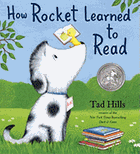It is rare to find an author who can move seamlessly from books aimed at toddlers to stories for children just beginning to unlock the mysteries of how letters form words. Tad Hills, who flew onto the picture book scene with his winning
Duck & Goose, here proves that he numbers among that elite group. Through a series of deceptively simple words and images rendered in oil and colored pencil, Hills tells a multilayered story about learning to read and making a friend. A shift in his palette conveys the passage of time, and the changes in the puppy hero's expressions and body language convey the furry pupil's gradual openness to his little feathered teacher's patient and persistent overtures.
On the title page, a black-and-white pup pleads with his eyes for you to read him the book he has fetched (the very same
How Rocket Learned to Read). First off, we meet Rocket, a dog who loves to play: "He loved to chase leaves and chew sticks. He loved to listen to the birds sing." One day, after a full morning of play, just when he's "settl[ing] in for a good nap," a little yellow bird alights on Rocket's tufted forehead. "Aha! My first student! Wonderful!" she sings. Rocket responds by moving on to a new napping place. The sequence of images that follow subtly yet brilliantly convey the bird's stamina: a full-bleed spread shows her mounting a banner of the alphabet (in both upper- and lower-case letters), while only Rocket's tail pokes out from behind a faraway bush. Her task completed, the bird perches on a tree branch in a full-bleed, full-page illustration, and begins the story of an unlucky dog, Buster, who has lost his favorite bone. Again, we see just the tip of Rocket's tail. Opposite, a vignette that creates the feeling of looking through a telescope zeroes in on Rocket behind a bush, the "teacher" barely visible in a treetop branch, obscured behind a book as large as she is. "At first Rocket was disturbed," and his expression shows it. But as Buster's story progresses, a series of vignettes depicts Rocket perking up. The little yellow bird flies off, leaving her furry listener with a cliff-hanger.

Now the pooch is hooked, and "every day Rocket returned to the little yellow bird's classroom." Each morning, Rocket learns a new letter, and student and teacher put the letters together. "G" and "R" spell brown-and-white-spotted Mr. Barker's growl ("GRRRRRRRRRR!"). Hills makes children aware of the omnipresence of sounds of all kinds--the sound of a dog's growl, the whoosh of the wind. Meanwhile, the sky darkens, and the leaves turn "R-E-D." It's fall--time for the little yellow bird to head south. "Don't forget! Words are built one letter at a time!" she cries as she flies off. In her absence, Rocket practices his letters; a snowy field becomes his whiteboard. He traces "A-B-C" in the snow, and sounds out "W-I-N-D" and "C-O-L-D." He even meets new friends, a terrier-looking "E-M-M-A" and "F-R-E-D," a Dachshund. Just when Rocket looks the most downcast, we watch the snow "M-E-L-T" and know that spring will soon return and the little yellow bird with it. Hills thus uses the words that Rocket spells to drive the plot forward. The pup sees the bird's chalkboard with the message "Class starts tomorrow," and spells "W-A-G" as he happily awaits his friend and instructor. All of the words are simple enough for beginning readers to sound out for themselves. And, of course, the tale of Buster, "the lucky dog who found his bone under the lilac bush," is one that Rocket and his yellow-feathered teacher read "again. And again. And A-G-A-I-N." Together Rocket and the little yellow bird reveal a magical world that reading opens up for all of us.--
Jennifer M. Brown




